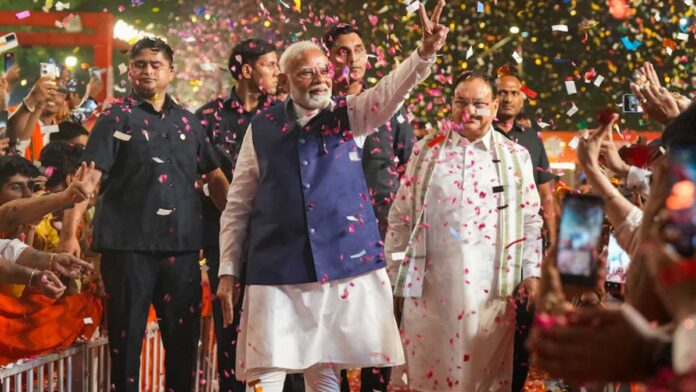
Yes, this day stands as a defining moment in India’s modern political history- the day India began its bold experiment to transform into a powerful nation, blending economic ambition with global influence. It was the day when the country’s strategic direction shifted dramatically under the vision of a single political party, and a powerful man, setting the course that would eventually position India among the world’s most influential nations.
It was on this day in 2014 that then Gujarat Chief Minister Narendra Damodardas Modi of the Bharatiya Janata Party (BJP) took oath as India’s 15th Prime Minister. The beginning of a new chapter in the country’s leadership. His swearing-in ended a ten-year-long tenure of the Indian National Congress and signalled a major shift in the nation’s politics. His swearing-in marked the end of a decade-long rule by the Indian National Congress. This moment was more than just a change in leadership- it signalled a major shift in the political landscape of India.
Modi Took Oath As PM For The First Time
On the evening of May 26, 2014, Narendra Modi took oath as the 15th Prime Minister of India in a grand ceremony held at the forecourt of Rashtrapati Bhavan. Modi had secured a sweeping mandate in the 2014 general elections, with his party, the Bharatiya Janata Party (BJP), winning 282 out of 543 seats—an absolute majority not seen since 1984. With the support of allies in the National Democratic Alliance (NDA), the total tally rose to 336 seats, marking a decisive break from the Congress-led UPA government, which managed just 44 seats.
Over 4,000 important people, officials, and guests attended the ceremony to watch Modi and his new team of ministers take their oaths in front of the then-President, Pranab Mukherjee. One of the most memorable moments that evening was the gathering of South Asian leaders- a first for any swearing-in ceremony in India, according to diplomats and experts. Notable guests included Pakistan’s then-Prime Minister Nawaz Sharif and Sri Lanka’s Mahinda Rajapaksa. Their presence sent a powerful message about Modi’s desire to rebuild and strengthen ties within the region.
Modi In Waistcoat
Dressed in his signature kurta and waistcoat, with a pen neatly clipped to his pocket, 63-year-old Modi took the oath in Hindi. With a calm yet determined voice, he promised to uphold the Constitution and serve every citizen “without fear or favour, affection or ill will.” In that historic moment, he also became the first Indian Prime Minister born after Independence- a symbol of a new era for the nation. His first Cabinet was much leaner than the outgoing Congress government’s 75-plus ministers. Shortly after election results were announced, Modi was named head of the party members in parliament, and he began forming a government that included not only senior BJP officials but also several leaders from parties allied with the coalition. His government focused on “minimum government, maximum governance”. Before being PM, he was Gujarat’s Chief Minister for over 12 years.
India’s Growth
Since 2014, India’s economy has been moving with remarkable energy. In the years leading up to the pandemic, the country was growing at a healthy 7-8%, a pace that reflected rising aspirations, expanding industries, and growing global confidence in India’s potential.
Various reports also suggest that under Modi’s leadership, India’s nominal GDP has more than doubled. According to the latest figures from the International Monetary Fund (IMF), it has gone up to around $2 trillion in 2014 to a projected $4.27 trillion in 2025. This is considered to be a remarkable economic transformation, fueled by structural reforms, infrastructure growth, digital advancements, and a renewed emphasis on manufacturing and investment.
BVR Subrahmanyam, CEO of NITI Aayog, cited IMF data while speaking at the 10th Governing Council Meeting of the policy think tank, where he highlighted the growth figures.
“We are the fourth largest economy as I speak. We are a $4 trillion economy as I speak, and this is not my data. This is IMF data. India today is larger than Japan. It’s only the United States, China, and Germany which are larger,” Subrahmanyam said.


